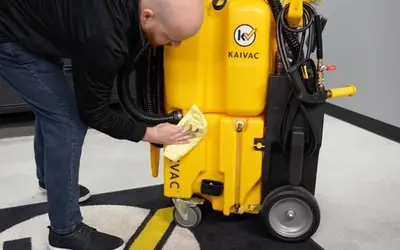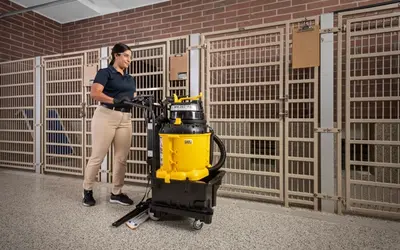Do Cleaning Workers Unintentionally Spread Disease?

Is it possible that cleaning workers may unintentionally spread disease because of the cleaning tools and equipment they use? Here’s a case study that provides some answers.
Case Study
In 2010, children attending a preschool started coming down with hand, foot, and mouth disease. Although this is a common childhood disease, for those of us not familiar with it, hand, foot, and mouth disease is caused by viruses, reports the Centers for Disease Control and Prevention. A person infected with one of these viruses is contagious. The most common symptoms are elevated temperature, rashes, and mouth sores.
The pathogens that trigger hand, foot, and mouth disease mainly spread by inhalation. However, in this preschool, it appeared the virus was also spreading by children touching contaminated surfaces. The floor where preschoolers spent the bulk of their day was .
But were the floors the culprit? Did touching the floor spread disease? School administrators determined that the only way to find out was to conduct a study. If the floors were the problem, the administrators could then take appropriate actions to stop the transmission of the disease.
Uncovering the Causes
Once completed, the study revealed many things. Staff cleaned floors with string mops and buckets. However, the staff did not regularly wash and sanitize the string mops, nor did they change them as frequently as they should be. They also did not regularly clean and sanitize mop buckets… Then staff used the same mops and buckets to clean many floor areas in the school. The problem here is that if the mop or bucket is contaminated with pathogens, the mopping process can spread those pathogens to other areas.
Overall, they were not observing floor-cleaning best practices. These include regular dust mopping or vacuuming of the floors; regular or daily cleaning to remove spills and soils; interim cleaning to remove surface-level embedded soils on a set basis; and restoration – stripping and refinishing floors one to three times per year. They were using floor cleaning solutions purchased in grocery stores. The solutions were also and not designed for professional use. They were not effectively cleaning surface areas such as counters, and often, they often used the same cleaning cloths repeatedly.
Addressing the Challenge
The study confirmed what school administrators suspected: the floors were contaminated, and these contaminants likely included the pathogens that cause hand, foot, and mouth disease. In other words, yes, the floors did spread disease.
The following steps were recommended to address the challenge and protect the health of the children:
- Avoid mopping floors. We have known from studies dating back to the early 1970s that floor mopping can spread disease. This is just one more example.
- Replace the mops and mop buckets with floor-cleaning alternatives. One such alternative is the Kaivac AutoVac Stretch™. This system replaces mops and mop buckets, preventing the spread of contaminants. The AutoVac removes soils, pathogens, and contaminants from surfaces as it moves over the floor. It’s perfect for medium to larger floor areas.
- Use microfiber to clean counters and similar surfaces. Microfiber captures and traps soils and contaminants for fast, hygienic cleaning.
- Another option is the KaiFly™. This system combines microfiber, a window squeegee, and chemical injection technologies. You apply it to surfaces to rapidly remove potential disease-causing bio-pollutants from desktops, chalk and dry erase boards, tabletops, stalls, partitions, and windows.
Case studies like this tell us that mops can collect pathogens and viruses and spread them to other floor surfaces. And we all know that mops and mop buckets are not cleaned, sanitized, or changed as frequently as necessary to stop the spread of germs.
Cleaning must not spread disease. If our goal is to keep building occupants healthy, the mops have got to go.
Case Study Source: Robert Shor, formerly a practicing physician and a cleaning consultant based in Florida.
Related Posts

Preventive Maintenance for Your No-Touch Cleaning® System
Your Kaivac No-Touch Cleaning system makes restroom maintenance fast and easy. Keeping your No-Touch Cleaning system in good working order is also fast and easy. Kaivac makes performing preventative maintenance and troubleshooting potential issues simple. No special equipment or technical expertise required.
Read more
The Best Dog Kennel Cleaning Equipment
There are ways to simplify the kennel cleaning process. Automatic kennel cleaning equipment can simplify the kennel cleaning process and can save hours of daily, back breaking labor–even for facilities without central drains.
Read more
A Better Retail Floor Care Option: How One National Retailer Reclaimed Floor Care
Discover how a national retailer cut costs and improved results by switching to Kaivac’s All Floor™ system—an easy, all-in-one floor care solution perfect for low-revenue retail locations.
Read more